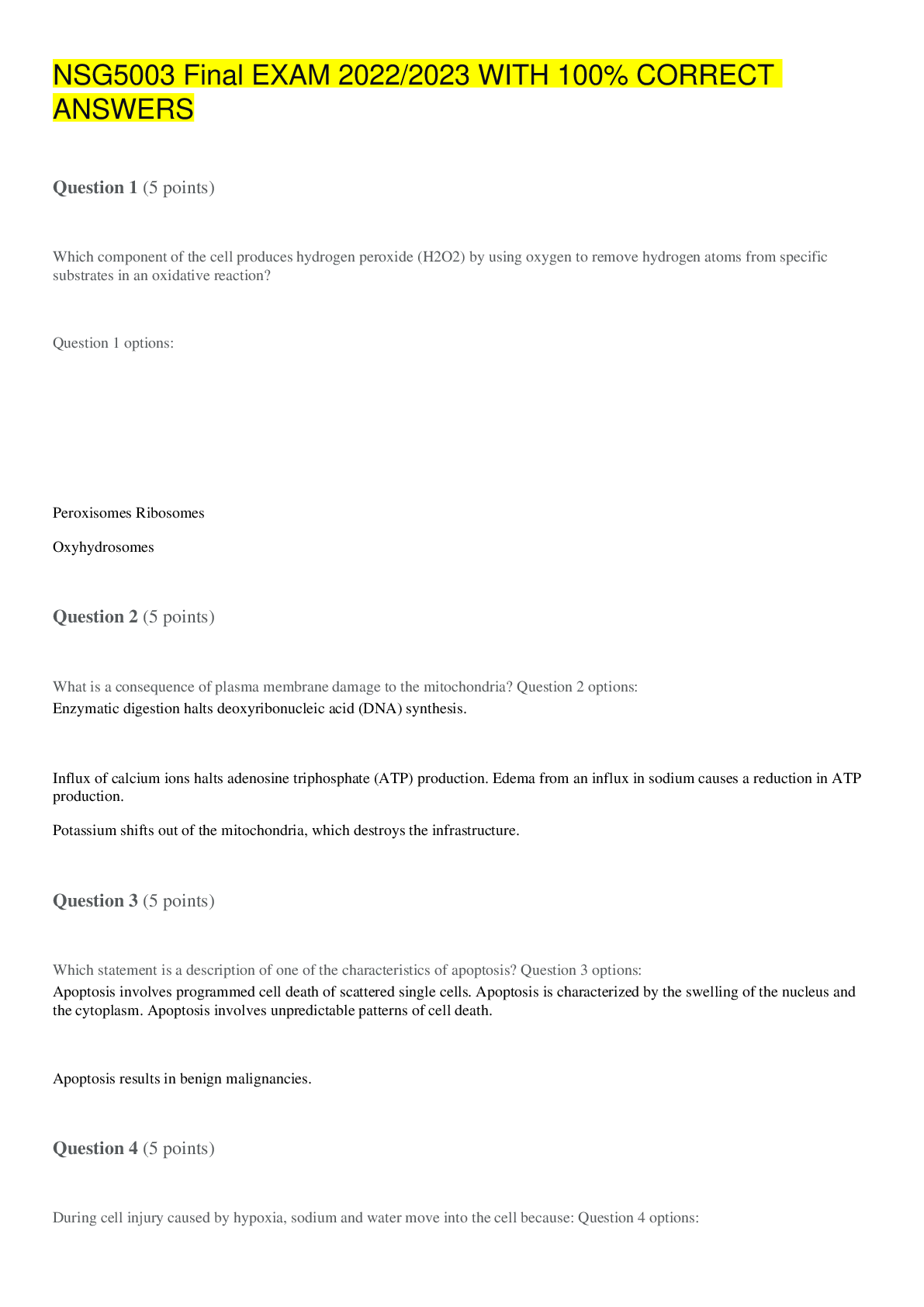*NURSING > Final Exam Review > Chamberlain College of Nursing Additional Study Notes for Final: NR 503 (All)
Chamberlain College of Nursing Additional Study Notes for Final: NR 503
Document Content and Description Below
• Be sure to review the terminology and concepts of the first four weeks: these concepts help to inform and support the last four weeks of the course. • All information listed on this review doc c... an be found in the course text, Gordis. Definitions of study designs: Chapter 10: Differentiate between the case-control and cohort studies. Ask yourself, which is used when, and why. Case-Control: • Examine the possible relationship of an exposure to a certain disease • Identify group of individuals with the disease (cases) • For comparison, gather a group of people without that disease (controls) • Determine what proportion of the cases were exposed and were not • Also determine what proportion of the controls were exposed and not • Text: Thus, in a case-control study, if there is an association of an exposure with a disease, the prevalence of history of exposure should be higher in persons who have the disease (cases) than in those who do not have the disease (controls). • Ask yourself: Why is this important to the NP in primary care? How does this inform a provider’s decision-making? Cohort Studies: Chapter 13: Comparing Cohort and Case-Control Studies: See Figure 13-1 and 13-2 (busy pictures but hang in there) Chapter 13 comparison of studies - important to review Matching: Chapter 10: Text: A major concern in conducting a case-control study is that cases and controls may differ in characteristics or exposures other than the one that has been targeted for study. Randomization: The point of randomization is to prevent any potential biases on the part of the investigators/researchers. Text: Thus, the use of randomization is crucial to protect the study from any biases that might be introduced consciously or subconsciously by the investigator into the assignment process. Bias: (selection bias) (source of cases) Issues related to generalizability; cases from a single source less than desirable than if from multiple sources with a varying pool of cases. Ask yourself, why? Causality:Table 14-3: Using the Evidence in Developing Recommendations Cross-Sectional Study: Both exposure and disease outcome are determined simultaneously for each subject. Testing a person for the relationship between the exposure (or existence of disease) with evidence of the disease. See figure 10-13 and example of serum cholesterol and ECG. Incidence Density Sampling: Text: An important consideration in case-control studies is whether to include incident cases of a disease (newly diagnosed cases) or prevalent cases of the disease (people who may have had the disease for some time). Hypothesis: Confirm or refute based upon study; statement of proposed relationship Bradford-Hill Criterion: Epidemiologist, statistician, developed the guidelines for evaluating whether an observed association is casual. • Temporal relationship • Strength of the association • Dose-response relationship • Replication of the findings • Biological plausibility • Consideration of alternate explanations • Cessation of exposure • Consistency with other knowledge • Specificity of the association Epidemiologic Transition: Trends or changes with time: Figure 4-26 Ratio Measure of Association: Proportional description of association, strength. Positive Predictive Value (influencers of value) Relate this to screening tests; what values are used to calculate the PPV. Odds Ratio: The odds ratio is the probability, the odds that the event will happen (sort of like betting). Prevalence Rate: The number of affected people in the population at a specific time…. Divided by the number of persons in the population at that time – this tells the proportion of the population affected by the disease at that time. Why is this important to understand??! So, if the prevalence rate is low, or going down, it tells us that (perhaps) the interventions we are implementing are useful, working, or that other conditions/situations have changed indicating a decreasing prevalence rate. OR, if it is going up, what might that indicate? Ineffective interventions? Demographic changes? Etc…. Incidence Rate: Measures of Morbidity: Text: The incidence rate of a disease is defined as the number of new cases of a disease that occur during a specified period of time in a population at risk [Show More]
Last updated: 2 years ago
Preview 1 out of 12 pages

Buy this document to get the full access instantly
Instant Download Access after purchase
Buy NowInstant download
We Accept:

Reviews( 0 )
$9.00
Can't find what you want? Try our AI powered Search
Document information
Connected school, study & course
About the document
Uploaded On
Apr 03, 2021
Number of pages
12
Written in
Additional information
This document has been written for:
Uploaded
Apr 03, 2021
Downloads
0
Views
92












